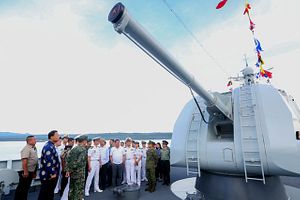On May 21, China held its first-ever naval exercise with Myanmar in yet another sign of Beijing’s deepening security role in the subregion, even amid lingering uncertainties about its rise.
China’s growing security role has been in the headlines of late as three warships from the People’s Liberation Army Navy (PLAN) Task Group 150 – the Changchun (DDG-150), a guided missile destroyer; the Jinzhou (FF-G532), a guided missile frigate; and the Chaohu (890), a replenishment ship – have been making their way across the subregion, through the Philippines, Vietnam, Malaysia, and now Myanmar. This is part of a broader, cross-continental, six-month naval diplomacy campaign which started in late April.
Of the previous Southeast Asian stops, the warships made the biggest headlines in the Philippines, where they paid the first goodwill visit by Chinese vessels to the country in seven years (See: “Why Did China’s Warships Visit the Philippines?”). The three-day trip to Sasa Wharf in Philippine President Rodrigo Duterte’s hometown of Davao City, which lasted from April 30 to May 2, saw Duterte float the possibility of exercises between the two countries just after he had issued a chairman’s statement following the 30th ASEAN Summit in Manila that was rightly chastised as being too soft on Beijing on the South China Sea question (See: “The Truth About Duterte’s ASEAN South China Sea Blow”).
This week, in another notable development, Beijing held its inaugural naval exercise with Myanmar in the Gulf of Martaban. The one-day joint exercise followed a port call in Thilawa by the PLAN warships.
China’s defense ministry said the exercise focused on subjects including communication, formation maneuver, and joint search and rescue operations. No additional details were publicly disclosed.
On the Chinese side, the participating vessels were Chinese guided-missile destroyer Changchun (Hull 150), the guided-missile frigate Jingzhou (Hull 532), and the comprehensive supply ship Chaohu (Hull 890). Meanwhile, Myanmar’s Navy dispatched the guided missile frigate UMS Aung Zeya and the guided missile corvette UMS Anawrahta.
Rear Admiral Shan Hao, the commanding officer of the Chinese naval taskforce, was reported as saying by the defense ministry that the exercise “enjoyed smooth command and close action” and that “the two navies’ capabilities were effectively tested by the various maritime subjects.”
Following the exercise, the PLAN task force sailed on to a port call at Chittagong in Bangladesh.

































